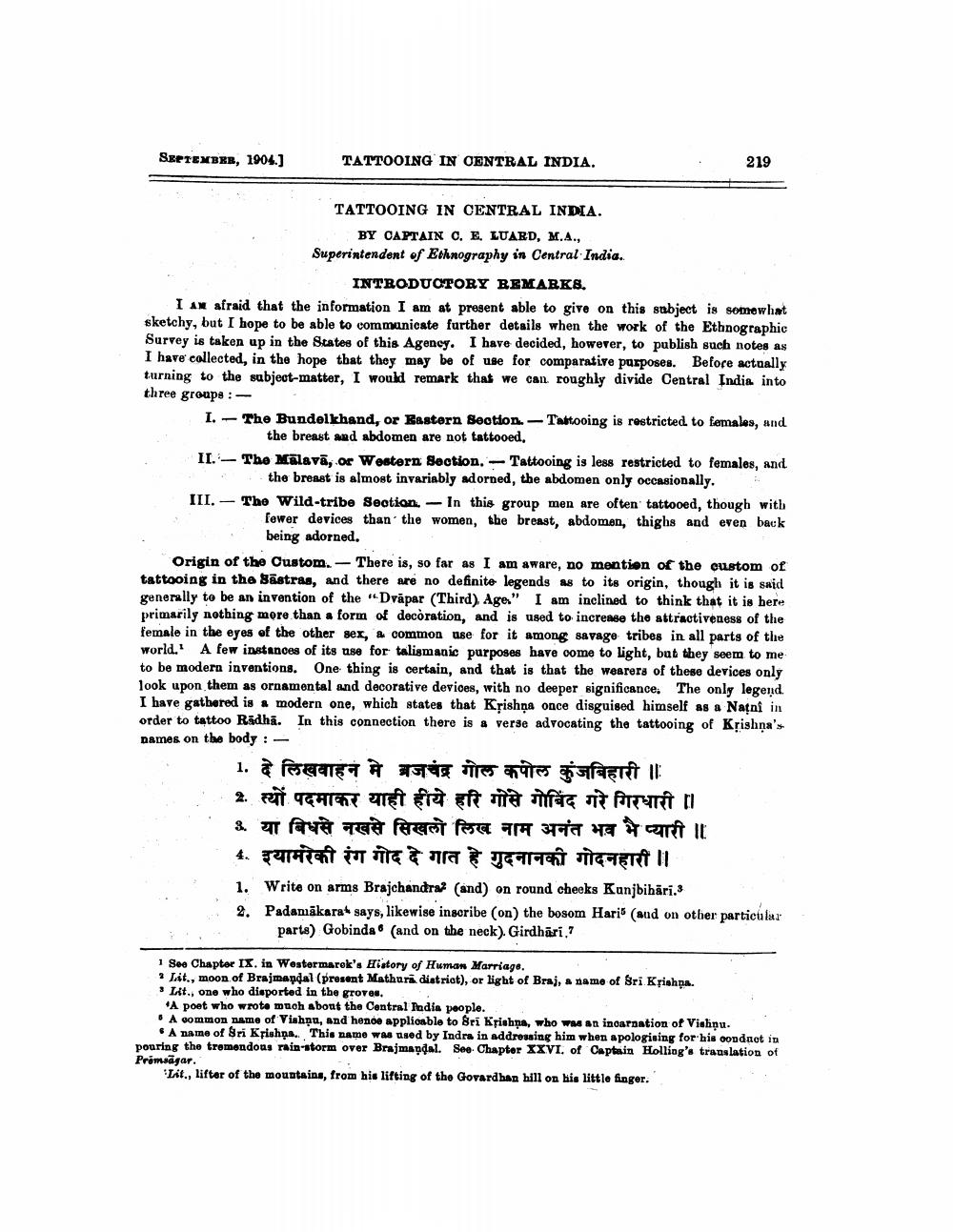________________
SEPTEMBER, 1904.]
TATTOOING IN CENTRAL INDIA.
TATTOOING IN CENTRAL INDIA.
BY CAPTAIN C. E. LUARD, M.A.,
Superintendent of Ethnography in Central India.
III.
INTRODUCTORY REMARKS.
I AM afraid that the information I am at present able to give on this subject is somewhat sketchy, but I hope to be able to communicate further details when the work of the Ethnographic Survey is taken up in the States of this Agency. I have decided, however, to publish such notes as I have collected, in the hope that they may be of use for comparative purposes. Before actually turning to the subject-matter, I would remark that we can roughly divide Central India into three groups:
I.
219
The Bundelkhand, or Eastern Section.Tattooing is restricted to females, and the breast and abdomen are not tattooed,
II. The Malava, or Western Section. Tattooing is less restricted to females, and the breast is almost invariably adorned, the abdomen only occasionally.
The Wild-tribe Section. In this group men are often tattooed, though with fewer devices than the women, the breast, abdomen, thighs and even back being adorned.
Origin of the Custom. There is, so far as I am aware, no mention of the custom of tattooing in the Sastras, and there are no definite legends as to its origin, though it is said generally to be an invention of the "Dvapar (Third). Age." I am inclined to think that it is here primarily nothing more than a form of decoration, and is used to increase the attractiveness of the female in the eyes of the other sex, a common use for it among savage tribes in all parts of the world. A few instances of its use for talismanic purposes have come to light, but they seem to me to be modern inventions. One thing is certain, and that is that the wearers of these devices only look upon them as ornamental and decorative devices, with no deeper significance. The only legend. I have gathered is a modern one, which states that Krishna once disguised himself as a Natni in order to tattoo Radha. In this connection there is a verse advocating the tattooing of Krishna's names on the body: -
1. दे लिखवाहन मे ब्रजचंद्र गोल कपील कुंजविहारी ॥
2. स्थों पदमाकर याही हीये हरि गोसे गोविंद गरे गिरधारी ॥ 3. या विसे नखसे सिखतो लिख नाम अनंत भव मे प्यारी ॥
4. इयामरेकी रंग गोद दे गात हे गुदनानकी गोदनहारी ।।
1. Write on arms Brajchandra? (and) on round cheeks Kunjbihari.3
2.
Padamākara says, likewise inscribe (on) the bosom Haris (and on other particular parts) Gobinda (and on the neck). Girdhari,7
1 See Chapter IX. in Westermarek's History of Human Marriage.
2 Lit., moon of Brajmandal (present Mathura district), or light of Braj, a name of Sri Krishna.
3 Lit., one who disported in the groves.
"A poet who wrote much about the Central Padia people.
A common name of Vishnu, and hence applicable to Sri Krishna, who was an incarnation of Vishnu.
A name of Sri Krishna. This name was used by Indra in addressing him when apologising for his conduct in pouring the tremendous rain-storm over Brajmaṇḍal. See Chapter XXVI. of Captain Holling's translation of Primsägar.
Lit., lifter of the mountains, from his lifting of the Govardhan hill on his little finger.




